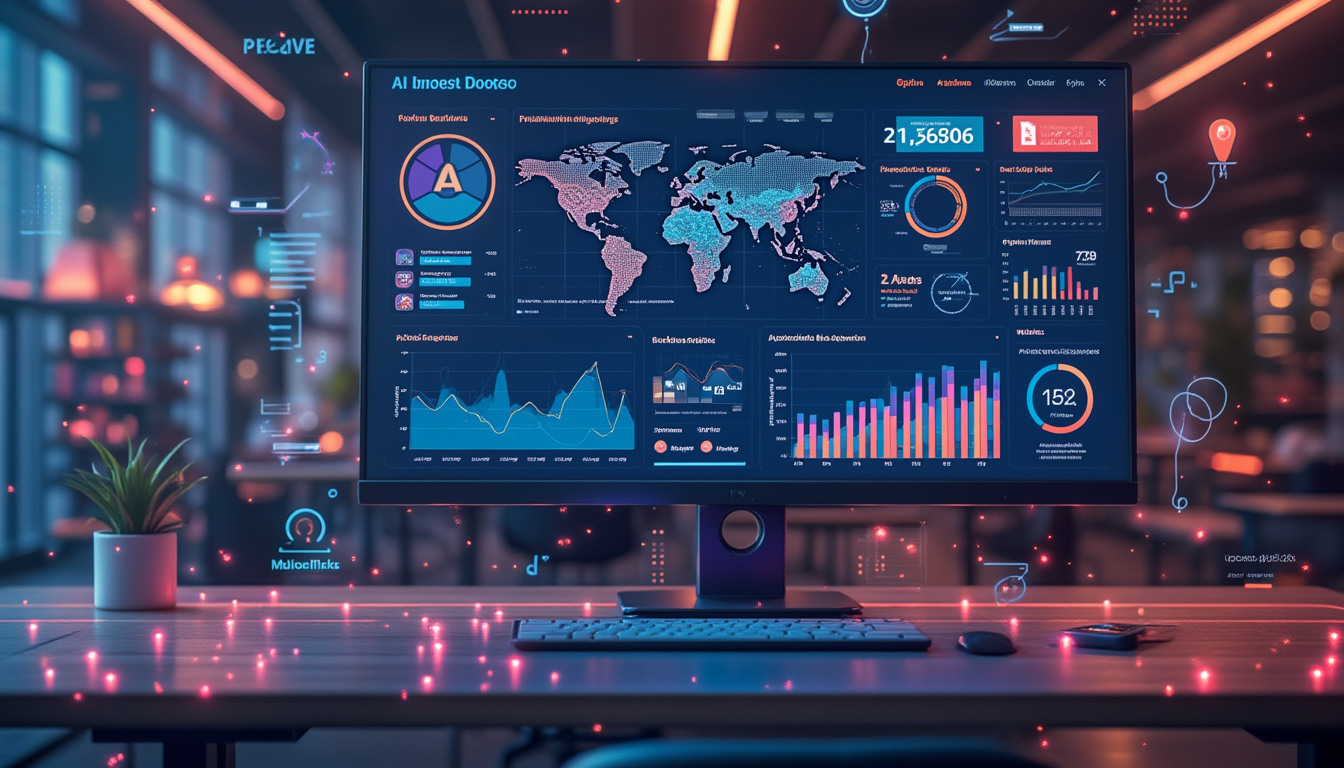Future of Backlink Monitoring: AI & Automation in SEO
AI-powered backlink monitoring is transforming SEO in 2025. Predictive analytics, automated risk detection, and next-gen tools for link management.

The backlink monitoring landscape is undergoing a dramatic transformation in 2025. What once required manual checking and basic alerts is now powered by artificial intelligence that can predict link losses, identify toxic patterns before they cause damage, and automate complex remediation workflows.
This shift isn't just about convenience—it's about survival in an increasingly complex SEO environment where Google's algorithm updates can instantly devalue years of link building work.
TL;DR
- AI now predicts which backlinks are at risk of being lost before they disappear
- Machine learning identifies toxic link patterns that traditional tools miss
- Automated workflows handle routine monitoring tasks while focusing human attention on high-impact decisions
- Predictive analytics forecast the SEO impact of link changes before they affect rankings
- Integration with content management and outreach tools creates seamless monitoring ecosystems
The AI-Powered Monitoring Revolution
Predictive Link Loss Detection
Traditional backlink monitoring tells you after a link is gone. AI-powered systems in 2025 can predict link losses days or weeks in advance by analyzing:
- Website health indicators: Server response patterns, site speed degradation, and technical issues
- Content freshness metrics: Pages that haven't been updated in months are more likely to be redesigned
- Publisher behavior patterns: Sites that frequently remove or modify external links
- Industry trend analysis: Seasonal content updates that typically affect link retention
Real-World Impact
Early adopters report 70% fewer "surprise" link losses when using predictive monitoring, allowing proactive outreach before valuable links disappear.
Machine Learning for Toxic Link Detection
While traditional tools rely on static metrics like Domain Authority or spam scores, AI systems analyze dynamic patterns:
Pattern Recognition Capabilities:
- Unusual link velocity spikes that indicate potential negative SEO attacks
- Cross-referencing linking domains for coordinated spam networks
- Content quality degradation on linking pages over time
- Behavioral signals from user interactions on linking sites
Automated Risk Scoring: Modern AI doesn't just flag potentially harmful links—it calculates the probability of algorithmic penalties and suggests prioritized remediation actions.
The New Monitoring Workflow
Stage 1: Intelligent Discovery
AI systems continuously scan for new backlinks across multiple data sources, not just traditional crawl databases. This includes:
- Social media mentions that convert to links
- PDF citations and academic references
- Image attribution links often missed by standard tools
- Dynamically generated links from database-driven sites
Stage 2: Automated Quality Assessment
Each discovered link undergoes real-time evaluation:
Contextual Analysis
AI reads the surrounding content to determine topical relevance and editorial context
Authority Verification
Multi-factor analysis beyond simple domain metrics, including user engagement and content quality
Risk Assessment
Machine learning models predict potential negative impacts based on historical penalty data
Value Projection
Algorithmic estimation of SEO and traffic value based on similar successful links
Stage 3: Proactive Intervention
Based on AI analysis, automated systems can:
- Pre-emptively disavow high-risk links before they cause damage
- Trigger outreach workflows to strengthen at-risk valuable links
- Adjust monitoring frequency based on link volatility patterns
- Generate optimization recommendations for anchor text distribution
Advanced Automation Capabilities
Intelligent Alert Prioritization
Instead of overwhelming users with notifications, AI systems rank alerts by:
- Business impact potential: Links driving actual traffic and conversions get higher priority
- Historical performance: Changes to previously high-performing links trigger immediate attention
- Competitive analysis: Links your competitors are also losing indicate industry-wide shifts
- Recovery difficulty: Some links are easier to recover than others—AI factors this into urgency
Dynamic Monitoring Frequency
| Feature |
|---|
| High-Value Editorial Links |
| Moderate Authority Links |
| Bulk Directory Links |
| Competitor Backlinks |
Cross-Platform Integration
Modern AI monitoring systems don't operate in isolation. They integrate with:
- Content Management Systems: Automatically update internal linking when external links change
- Outreach Tools: Trigger personalized re-engagement campaigns for lost high-value links
- Analytics Platforms: Correlate link changes with traffic and ranking fluctuations
- Social Media Management: Monitor brand mentions that could become linking opportunities
The Data Advantage
Comprehensive Link Intelligence
AI-powered monitoring provides unprecedented insights:
Historical Pattern Analysis:
- Seasonal link acquisition and loss patterns for your industry
- Publisher behavior trends that affect link longevity
- Correlation between content types and link retention rates
Competitive Intelligence:
- Real-time tracking of competitor link gains and losses
- Industry benchmark comparisons for link velocity and quality
- Gap analysis highlighting untapped linking opportunities
Key Insight: Companies using AI-powered monitoring report 3x more accurate predictions of which link building strategies will succeed, based on historical pattern analysis across millions of links.
Predictive Modeling for Link Building ROI
Beyond monitoring existing links, AI helps optimize future link building investments by:
- Success probability scoring for potential link targets
- Expected value calculations based on similar successful placements
- Resource allocation optimization across different link building strategies
- Timeline predictions for when link building efforts will show ranking improvements
Implementation Strategies for 2025
Choosing the Right AI-Powered Tools
When evaluating next-generation monitoring platforms, prioritize:
- Predictive capabilities: Can it forecast link losses and opportunities?
- Integration ecosystem: Does it connect with your existing SEO stack?
- Customization options: Can you train the AI on your specific industry patterns?
- Automation depth: How much manual work can it eliminate?
- Transparency: Can you understand and validate the AI's recommendations?
Building an AI-First Monitoring Strategy
Audit Current Tools
Identify gaps in your existing monitoring setup and quantify manual time spent
Define Success Metrics
Establish baselines for link retention, risk detection accuracy, and time savings
Pilot Implementation
Start with your highest-value links to test AI accuracy and workflow integration
Train the System
Provide feedback on AI recommendations to improve accuracy for your specific situation
Scale and Optimize
Gradually expand coverage while refining automated workflows based on performance data
Preparing Your Team
The shift to AI-powered monitoring changes how SEO teams operate:
New Skills Needed:
- Understanding AI recommendation systems
- Interpreting predictive analytics
- Managing automated workflows
- Strategic thinking about link portfolio optimization
Evolving Responsibilities:
- Less time on routine checking, more on strategic analysis
- Focus shifts from reactive problem-solving to proactive optimization
- Increased emphasis on relationship building and high-level strategy
Common Implementation Pitfalls
Over-Reliance on Automation
While AI handles routine tasks excellently, human oversight remains crucial for:
- Relationship management: AI can't build genuine connections with publishers
- Creative problem-solving: Complex link recovery often requires human creativity
- Strategic context: Understanding business priorities that AI might miss
Ignoring Integration Requirements
Integration Is Key
AI monitoring tools work best when integrated with your entire SEO ecosystem. Isolated tools, no matter how advanced, limit the benefits of automated workflows and comprehensive analysis.
Insufficient Training Data
AI systems improve with more data. Teams that don't invest time in:
- Properly categorizing their existing links
- Providing feedback on AI recommendations
- Sharing historical link building performance data
Often see suboptimal results compared to those who take a more collaborative approach with their AI tools.
The Competitive Advantage
Speed and Scale Benefits
Organizations using AI-powered monitoring gain significant advantages:
- Faster issue resolution: Problems identified and addressed before they impact rankings
- Larger link portfolios: Ability to monitor 10x more links with the same resources
- Better resource allocation: AI insights help prioritize high-impact activities
- Proactive optimization: Continuous improvement rather than reactive maintenance
Future-Proofing Your SEO Strategy
As Google's algorithms become more sophisticated, manual monitoring becomes increasingly inadequate. AI systems adapt to algorithmic changes by:
- Learning from algorithm updates: Automatically adjusting risk assessments based on new penalty patterns
- Evolving quality signals: Updating evaluation criteria as search engines refine their preferences
- Cross-platform correlation: Identifying new ranking factors through multi-source data analysis
The companies seeing the biggest SEO gains in 2025 are those that embraced AI-powered monitoring early, giving their systems time to learn and optimize for their specific situations.
Looking Ahead: The Next Evolution
Emerging Technologies
Several technologies will further transform backlink monitoring:
Natural Language Processing Advances:
- Better understanding of content context and editorial intent
- Automated assessment of brand sentiment in linking content
- Real-time detection of content changes that affect link value
Blockchain Integration:
- Immutable records of link building investments and outcomes
- Transparent verification of link authenticity and editorial nature
- Smart contracts for automated link building arrangements
Advanced Predictive Modeling:
- Industry-wide pattern recognition for macro SEO trends
- Individual website behavior prediction with 90%+ accuracy
- Real-time adjustment of monitoring strategies based on algorithmic shifts
Preparing for What's Next
To stay ahead of the curve:
- Invest in data quality: Clean, well-organized historical data will fuel better AI insights
- Build flexible systems: Choose tools that can adapt to new technologies
- Maintain human expertise: AI amplifies human intelligence—it doesn't replace strategic thinking
- Focus on relationships: Technology can't replace genuine publisher relationships
BacklinkDog combines cutting-edge monitoring technology with practical, user-friendly alerts. Focus on the links that matter most while our intelligent system handles the routine surveillance work.
Start Your Free TrialConclusion
The future of backlink monitoring is already here, and it's powered by artificial intelligence. Organizations that embrace these technologies now will have significant advantages over those clinging to manual processes and reactive strategies.
The key is finding the right balance: leveraging AI for speed, scale, and predictive insights while maintaining human oversight for strategy, relationships, and creative problem-solving.
As we move deeper into 2025, the question isn't whether to adopt AI-powered monitoring—it's how quickly you can implement these systems and train them to optimize your specific link portfolio.
Start Monitoring Your Backlinks Today
Don't wait for broken links to hurt your SEO. BacklinkDog monitors your backlinks 24/7 and sends instant alerts when issues arise, so you can fix them before they impact your rankings.
Get started


